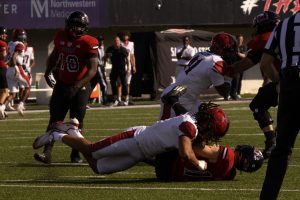Big brothers, sisters, play parents’ roles
January 15, 1987
While more than 25 NIU faculty members and students are big brothers or big sisters to a single-parent child, 36 children are still on waiting lists.
Terry Schade, Family Service Agency case worker, said the agency finds a big brother or sister for children between the ages of seven and 13.
These children have little or no contact with either parent because of divorce or various other reasons, she said. The big brother or sister takes the place of the absent parent by acting as the male or female role model, she said.
Anne Carter, NIU student and big sister, said she became a big sister because she has not had much experience with children since she has been at college, and this was a way to share herself with someone else. She said, “You get so much out of it, (and) the children look forward to seeing you.”
Stan Wayne, NIU faculty member and big brother, said becoming a big brother would be a “good community contribution, and it would help someone who doesn’t have a parent.
uthe Howes, NIU student and big sister, said becoming a big sister was something that interested her. This is her second little sister because the first one moved, she said.
Schade said someone who wants to be a big brother or sister must complete the four required steps. The first step consists of faculty or students attending an orientation meeting, either a regularly scheduled meeting or an individual meeting, she said.
The agency then requires three references from someone who has known the volunteer for at least one year, Schade said. The agency sends out and receives the references at the office to ensure their confidentiality, she said.
The next step is being interviewed by the agency in order for the agency to find out the volunteer’s background, values and goals.
The interviews help the agency in matching the child with the volunteer, she said. The agency also interviews each child to find out what they are like and what they like to do, Schade said.
The final step is either being accepted or rejected by the agency, Schade said. If accepted, the agency will match the child with the volunteer.
Both the volunteer and the child are interviewed extensively and are matched together on the basis of commom interests and geography, she said. The big brother or sister thinks of different activities to do with his little brother or sister, usually something which is not expensive, Schade said.
Carter said she spends about four to five hours each week with her little sister. She said they like to swim and bowl, and soon, Carter would like to show her little sister how to develop pictures in a dark room.
Wayne said his little brother is extremely creative and likes to work on art projects, as well as watching T.V. and going to the video arcade.
owes said she takes her little sister out for dinner or to the movies, and at Howes apartment they play games or bake.
Wayne said being a big brother requires time and commitment. “You need to be serious about it,” Carter agreed. The children depend on their big brother or sister to consistently plan activities for them to do together, she said.
Schade said there are still 36 children from the entire county on the waiting list to receive a brother or sister. Carter said the agency mostly needs big brothers because there are not as many big brothers interested as big sisters.
Schade said there are certain requirements the big brother or sister must maintain. They meet once a week with the child and spend at least two to four hours with the child. During the summer they must make an effort to see the child once every two weeks and write or call once a week, she said.






